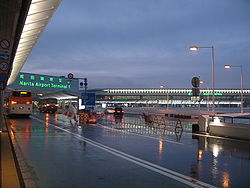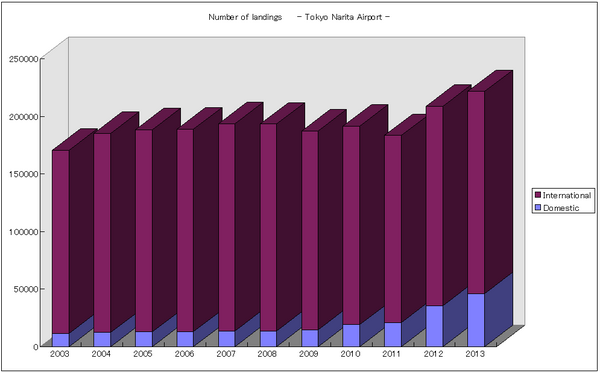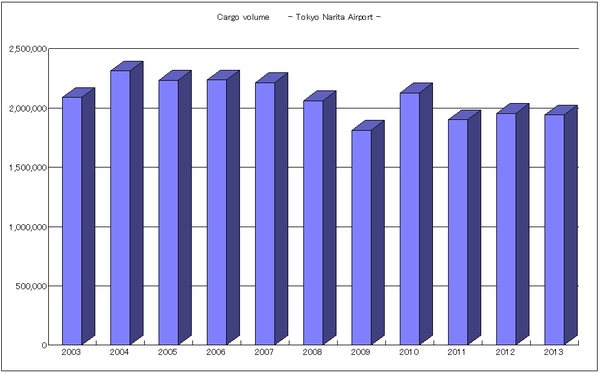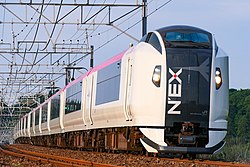Narita International Airport
The Narita Jasiko International Airport (成田国際空港, Narita Kokusai Kūkō?) (IATA: NRT, ICAO: RJAA), also formerly known as Airport International Tokyo-Narita or New Tokyo International Airport, is one of two international airports serving the Greater Tokyo Area of Japan. It is located about 60 kilometers (37 miles) east of central Tokyo. It is located in Narita, Chiba, Japan.
Narita is Japan's predominant international airport, handling about 50% of the country's international passenger traffic and 60% of international air cargo traffic. In 2013, Narita was Japan's second-busiest airport (after Haneda Airport in Tokyo) and the 10th largest air cargo hub in the world. Its 4,000-meter (13,123 ft) runway is the record-holding runway for the longest runway in Japan alongside the second runway at the International Airport from Kansai in Osaka.
It acts as a hub for Japan Airlines, All Nippon Airways and Nippon Cargo Airlines as well as a hub for low-cost airlines Jetstar Japan and Peach.
At Narita, air traffic movements have been controlled under various noise-related operational restrictions. As a result, the airport must be closed from 00:00 (12:00 AM) to 06:00 (6:00 AM) the following day to minimize the impact of noise around the airport.
History
Plans for the construction of this airport began in 1962 due to congestion at Haneda International Airport (in Tokyo) and was not without conflicts with farmers whose land was expropriated. The airport finally came into operation in 1978 under the name New Tokyo International Airport. On April 1, 2004, it was given its current name (Narita International Airport).[citation needed]
In 1986, the airport began a second phase of construction, culminating in the opening of the second runway in April 2002, just in time for the World Cup in Korea and Japan.
Narita is a busy airport. Because of this, the Japanese authorities have limited the number of flights that each company can operate from Narita, making it an expensive airport for both companies and users. Recently, the Haneda International Airport in Tokyo was authorized to receive new international flights from Asia to lighten Narita's load. Haneda is located just 14 km from Tokyo Central Station, which is why it is preferred by executives, while Narita is geared towards tourists.
Privatization
In 2003, the Narita International Airport Corporation Act provided for the privatization of the airport. As part of this change, on April 1, 2004, New Tokyo International Airport was officially renamed Narita International Airport, reflecting its popular designation since its opening. The airport passed from government control to the authority of a new company called Narita International Airport Corporation.
Terminals
Narita Airport was one of the first airports in the world to align its terminals around the three major international airline alliances. Since 2006, the airport has organized the airport so that SkyTeam can use Terminal 1 North Wing, Terminal 1 South Wing for Star Alliance airlines, and Terminal 2 for Oneworld airlines.
Terminal 1
Terminal 1 uses a satellite terminal layout divided into a North Wing (北ウイング kita-uingu), Central Building (chūō-biru) and a Wing South. Two circular satellites, Satellite 1 (doors 11-18) and Satellite 2 (doors 21-24), are connected to the north wing. Satellites 3 and 4 (gates 26-38 and 41-47) gates make up a linear esplanade connected to the central building. The Satellite 5 terminal (gates 51-58) is connected to the south wing.
Check-in is processed on the fourth floor, and departures and immigration control are on the third floor. Passengers arrive through the second floor immigration post, collect their luggage and clear customs on the first floor. Most shops and restaurants are located on the fourth floor of the Central Building. The South Wing includes a duty-free shopping mall called 'Narita Nakamise', the largest airport boutique shopping mall of the franchised brand in Japan.
Japan Airlines used Terminal 1 before joining Oneworld.
The North Wing has served as a hub for the SkyTeam alliance since 2007, when Delta Air Lines and Aeroflot joined Air France, KLM, Korean Air, Aeroméxico and other SkyTeam airlines already operating there. As of 2015, Aircalin is the only non-SkyTeam airline operating from the North Wing.
The South Wing and Satellite 5 opened in June 2006 as a terminal for Star Alliance airlines. The construction of the South Wing took almost a decade and more than doubled the area of Terminal 1, with a total of 440,000 square meters. This wing is currently used by all Star Alliance members, along with non-members Air Busan, MIAT, Uzbekistan Airways and Etihad Airways.
Terminal 2
Terminal 2 is divided into a main building (honkan) and the satellite, both of which are designed around linear concourses. The two were connected by a shuttle system (Narita Airport Terminal 2 Shuttle System), which was designed by Otis and was Japan's first cable shuttle system. A new walkway between the main and the satellite was built, starting to work on September 27, 2013, and the transportation system was discontinued.
Check-in, check-out and immigration control for arriving passengers is on the second floor, while baggage claim and customs are on the first floor.
For domestic flights, there are three gates (65, 66 and 67) in the main building that connect to both the main departures and a separate domestic check-in facility. Connecting passengers between domestic and international flights must exit the area to the check-in area, and then check in for their connecting flight.
Japan Airlines is currently the main operator at T2. The terminal has served as the hub of the Oneworld alliance in Narita since 2010, some airlines that operate there are British Airways, Cathay Pacific, American Airlines and the most recent addition of Iberia, which since October 2016 operates direct flights to Madrid. Other airlines have also started using the terminal, including SkyTeam carriers China Airlines and China Eastern Airlines, as well as Star Alliance's Air India, and non-affiliates such as Air Macau, Air Niugini, Asia Atlantic Airlines, Eastar Jet, Emirates, Pakistan International Airlines, Philippine Airlines and Scoot.
Vanilla Air, a low-cost airline, is headquartered inside Terminal 2, but operates out of Terminal 3.
All Nippon Airways and other Star Alliance airlines used Terminal 2 prior to the opening of the South Wing of Terminal 1 in 2006.
Terminal 3
A third low-cost airline terminal was inaugurated on 8 April 2015. Located 500m north of Terminal 2, the new terminal incorporates a number of cost reduction measures, including the use of tags instead of illuminated directional signs and the use of airstairs doors and stairs instead of fingers, which are intended to reduce facility costs for airlines and their passengers by 40% on international flights and 15% on domestic flights. Jetstar Japan, Vanilla Air and three other low-cost airlines use the terminal. The terminal also includes a 24-hour food court that is the largest airport food court in Japan, and an Islamic prayer hall. It was built at a cost of 15 billion yen and covers 66,000 square meters of floor space.
Other infrastructures
Nippon Cargo Airlines (NCA) is headquartered on the grounds of Narita Airport, in the NCA Line Maintenance Hangar.
Japan Airlines also operates at the airport as a cargo center, at the Japan Airlines Narita Operation Center. The subsidiary airline JALways also had its headquarters in the building. All Nippon Airways also has a "Sky Center" of operations adjacent to Terminal 1, which serves as the headquarters of ANA Air Service Tokyo, a ground service provider that is a joint venture between ANA and the airport authority.
The airport is connected by a 47-kilometre pipeline to the port of Chiba City and a fuel terminal in Yotsukaido. The pipeline opened in 1983, and 130 billion liters of fuel had been pumped into Narita Airport by its 30th anniversary of operations in 2013.
Airlines and destinations
Domestic destinations
International destinations
Load
| Airlines | Destinations
|
|---|---|
| Air China Cargo | Beijing-Capital, Shanghai-Pudong |
| Air France Cargo | Paris-Charles de Gaulle |
| Air Hong Kong | Hong Kong |
| AirBridge Cargo | Amsterdam, Moscow-Sheremetyevo, Seoul-Incheon |
| Alitalia Cargo | Milan–Malpensa, Rome−Fiumicino |
| ANA Cargo | Bangkok-Suvarnabhumi, Canton, Dalian, Frankfurt, Hong Kong, Jakarta-Soekarno-Hatta, Naha, Osaka-Kansai, Beijing-Capital, Qingdao, Seoul-Incheon, Shanghai-Pudong, Singapore, Taipei-Taoyuan, Xiamen |
| Asiana Cargo | Seoul–Incheon |
| Cargolux | Luxembourg, Seoul-Incheon, Novosibirsk |
| Cargolux Italy | Luxembourg, Milan–Malpensa |
| Cathay Pacific | Hong Kong, Taipei-Taoyuan |
| China Airlines Cargo | Taipei-Taoyuan |
| China Cargo Airlines | Shanghai-Pudong |
| DHL Aviation | Anchorage, Chicago-O'Hare, Cincinnati, Hong Kong, Leipzig, Seoul-Incheon |
| Emirates SkyCargo | Dubai-Al Maktoum |
| EVA Air Cargo | Taipei-Taoyuan |
| FedEx Express | Anchorage, Canton, Hong Kong, Memphis, Oakland, Osaka-Kansai, Paris-Charles de Gaulle, Seoul-Incheon, Shanghai-Pudong, Taipéi-Taoyuan |
| KLM Cargo | Amsterdam |
| Korean Air Cargo | Bogotá, Seoul-Incheon |
| Lufthansa Cargo | Frankfurt, Seoul-Incheon |
| MASkargo | Johor Bahru, Kuala Lumpur-International, Penang |
| Nippon Cargo Airlines | Amsterdam, Anchorage, Bangkok–Suvarnabhumi, Chicago–O'Hare, Dallas/Fort Worth, Edmonton, Hahn, Hong Kong, Los Angeles, Milan–Malpensa, Nagoya–Centrair, New York–JFK, Osaka–Kansai, Beijing–Capital, San Francisco, Seoul–Incheon, Shanghai–Pudong, Singapore, Tian |
| Polar Air | Anchorage, Cincinnati, Hong Kong, Los Angeles, Seoul-Incheon, Shanghai-Pudong, Shenzhen, Sydney, Taipei-Taoyuan |
| Qatar Airways Cargo | Doha |
| SF Airlines | Wuhan, Xi'an |
| Silk Way Airlines | Baku |
| Singapore Airlines Cargo | Bangkok-Suvarnabhumi, Singapore |
| UPS Airlines | Anchorage, Louisville, Ontario, Osaka-Kansai, Shanghai-Pudong, Shenzhen |
| YTO Cargo Airlines | Yantai |
Statistics
Source: Narita International Airport Corporation(NAA), Airport Operational Status
Transportation
Train
The Narita Express is a Japan Railways railway service that connects the airport with the city of Tokyo, in a journey that takes 53 minutes to reach Tokyo station, 80 to Shinjuku station and 90 to Omiya and Yokohama. It is the fastest method, but also the most expensive. Each ticket costs between 3,000 and 4,500 yen in economy class.
Japan Railway also offers a fast service to Tokyo Station which takes 90 minutes but at a lower cost.
There are also lines from the private company Keisei that go to the Nippori and Ueno stations, both in the express service (the so-called Skyliner trains that do not make intermediate stops) and the limited express that have frequent stops along the way. route. The latter are usually the cheapest alternative to get to the capital (about 1000 yen).
Bus
Several companies also offer bus service, called Limousine Bus, but these are much slower than the various railway lines, due to Tokyo's always congested traffic.
There are also night bus services to Kyoto and Osaka. The buses also travel to US military bases, including Yokosuka Naval Base and Yokota Air Base.
Taxi
There is also a taxi service, but its price is prohibitive. The rides cost between 14,000 and 20,000 yen (with an extra 1,450 yen for highway tolls).
Helicopter
Mori Building City Air Service offers a helicopter charter service between Narita and the Ark Hills complex in Roppongi, taking 35 minutes and costing 280,000 yen each way for up to five passengers.
Image gallery
Images of different aircraft passing through the airport:
Nearby airports
The nearest airports are:
- Ibaraki Airport (46km)
- Haneda International Airport (61km)
- Oshima Airport (143km)
- Fukushima Airport (162km)
- Miyake Jima Airport (203km)
Contenido relacionado
Valencia (Venezuela)
Arauca (Colombia)
Poland

























